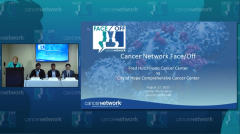
REMIX Study: Ixa-Len-Dex for Relapsed/Refractory Myeloma
Outcomes of the REMIX study investigating the effectiveness and tolerability of ixa-len-dex in real-world relapsed/refractory myeloma patients, exploring progression-free survival, overall response rate, and safety.
Episodes in this series

Transcript:
Judy Schreiber, PhD, RN: We’re moving on to the next presentation from Dr Liu on the REMIX study. Then we’ll have questions and answers after that again. Thank you.
Lawrence W. Liu, MD: Essentially, the REMIX study was looking into the real-world effectiveness of ixa-len-dex [ixazomib, lenalidomide, and dexamethasone] in relapsed/refractory multiple myeloma. As mentioned, it’s a prospective, real-world study. It was centered in France. They evaluated 376 patients receiving second-line or later ixa-len-dex. Their primary outcome was progression-free survival [PFS], and then other outcomes they looked into [were] overall survival, overall response rate. They also analyzed these by line of therapy and frailty status and age. Essentially, [the] objective was to report on the real-world ixa use in a nonselected patient population.
And overall, I should talk a little bit about comparisons to the TOURMALINE-[MM1] trial [NCT01564537] in terms of baseline characteristics. They had an older population, slightly worse ECOG score, but [fewer] high-risk cytogenetics. About 44% of the patients had history of autologous stem cell transplantation. Around 40% had prior lenalidomide use. Around 40% had prior thalidomide use. Greater than 90% had [prior] proteasome inhibitor use, and greater than 90% [had] Velcade [bortezomib] as well. This did run from 2017 to 2019. The baseline characteristics…make sense for that time frame.
These are all the PFS curves. The upper left is for the whole cohort and the median was 19.5. The upper right is by line of therapy. Red and blue are lines 2 and 3, respectively. They…each [had a] median of 21 months. Line 3, the green line, is essentially lines 4 and later. That had a median of 5.8 months. The bottom left is by age group. Essentially, the red, you can see, is the younger population. The blue is over 80. The median PFS was 17.4 vs 19 months, respectively. The lower right is by frailty status. The [frailer] population was in blue and then the non-frail was in red. Essentially the PFS was 14.6 months median for the frail patient population, and then 21 for the nonfrail population.
CR [complete response] rates were pretty much similar across the different groups, lines 2 and 3, across the age [groups] and for the whole cohort…around 15%. Overall response rate [was] relatively similar, 70% to 80%. The exact numbers [are] 14.3% for CR for the whole cohort and 73% overall response rate. There’s a good response duration median around 11 months overall. This was also across lines in age groups. Median overall survival was not reached in lines 2 and 3. For [the second-line] setting, the 48-month overall survival was 52%, so that’s close to the median, and 18.5 months for lines 4 and later. There was similar PFS between the lenalidomide-exposed and -unexposed groups, medians of 19.5 vs 22.6.
In terms of cytogenetics in the group, the median PFS for cytogenetics, standard risk, was 21 months and then high risk was around 19 months. In lenalidomide refractory, they only had about 6 patients. It’s difficult to draw a conclusion, but I would estimate it was around 9 to 12 months median PFS. In terms of safety data, adverse events [were] noted in 78.2%, including around 50% [with] severe [events] and 40%…deemed to be treatment related. Of the treatment related, the most common were diarrhea, around 13%; thrombocytopenia, 12%; nausea, 8%; and then severe fatigue, around 7%. In terms of the overall [adverse events] that were experienced, diarrhea was probably double the ones that were deemed to be treatment related, so about 26%. Anemia, neutropenia, vomiting, and neuropathy [were] around 4% or less. Of note, dose reductions were required in about a quarter for ixa and then required in about a third for lenalidomide. Also of note, there were 10% of patients who started with dose reductions in ixa, and then about 40% started with dose reductions in len.
Overall, just summing it up, we do have some concluding questions. Would we agree with the study’s conclusion that this is an effective and tolerable regimen, especially in the frail and older population, since this was one of their primary purposes of proceeding with this study? And then how does the efficacy of this regimen compare with others in the second- and third-line setting? And then, how does [the] tolerability of this regimen compare with others as well? My overall opinion is that…this represents a good option for patients, especially now as we have the results from the GRIFFIN trial [NCT02874742], and a lot of patients are going to become triple class exposed by the time of the second line. I think that the efficacy is…impressive to me in the sense that there were a lot of patients with dose reductions and treatment pauses, and the efficacy still held up in this population. It might have a lower PFS than the triplet regimens that contain dara, but also with [fewer] infections and [fewer] cytopenias as well. I think it’s…a balanced question. I’m curious what your guys’ thoughts are on this regimen.
Transcript is AI-generated and edited for clarity and readability.
Newsletter
Stay up to date on recent advances in the multidisciplinary approach to cancer.


































































































